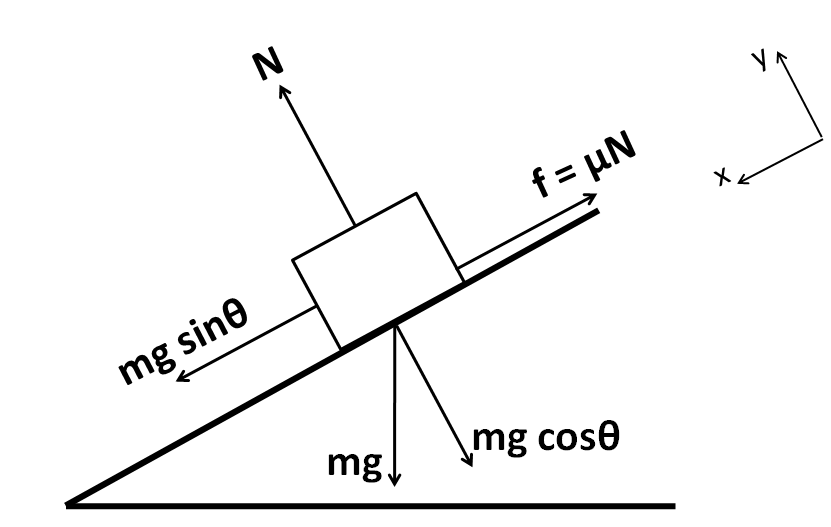
Define angle of repose.
Answer
508.3k+ views
Hint
To answer this question, we need to know that the angles defined in mechanics are mostly related to the inclined plane and friction. As the name suggests, the term is related to an object resting on an inclined plane and the corresponding angle of inclination.
Complete step by step answer
The angle of repose is defined as the angle which an inclined plane makes with the horizontal, when a body placed on it is on the verge of sliding down.
Consider a body of mass$m$placed on a rough inclined plane with angle of inclination $\theta $ and having coefficient of friction $\mu $.

Applying the equilibrium of the forces along y-direction, we have
$\Rightarrow N - mg\cos \theta = 0$
$\Rightarrow N = mg\cos \theta $ (1)
Now, applying the equilibrium of the forces along x-direction
$\Rightarrow mg\sin \theta - f = 0$
As the block is on the verge of sliding, the maximum possible value of friction must be there between the block and the plane.
So that $f = \mu N$, thus
$\Rightarrow mg\sin \theta - \mu N = 0$ (2)
Substituting (1) in (2), we have
$\Rightarrow mg\sin \theta - \mu (mg\cos \theta ) = 0$
$\Rightarrow mg\sin \theta = \mu (mg\cos \theta )$
Dividing both sides by$mg\cos \theta $, we get
$\Rightarrow \tan \theta = \mu $
Taking tangent inverse both sides, we get=t
$\Rightarrow \theta = {\tan ^{ - 1}}\mu $
This is the required expression for the angle of repose.
Hence, the angle of repose is equal to the inverse tangent of the coefficient of friction between the block and the plane.
Note
The angle of repose is very much important in the designing of the systems for the processing, storage, and conveying systems of particulate materials. If the grains are smooth, they have a low value of coefficient of friction, and hence the angle of repose is low. But if the grains are sticky, the high value of the coefficient of friction leads to the higher value of the angle of repose.
To answer this question, we need to know that the angles defined in mechanics are mostly related to the inclined plane and friction. As the name suggests, the term is related to an object resting on an inclined plane and the corresponding angle of inclination.
Complete step by step answer
The angle of repose is defined as the angle which an inclined plane makes with the horizontal, when a body placed on it is on the verge of sliding down.
Consider a body of mass$m$placed on a rough inclined plane with angle of inclination $\theta $ and having coefficient of friction $\mu $.

Applying the equilibrium of the forces along y-direction, we have
$\Rightarrow N - mg\cos \theta = 0$
$\Rightarrow N = mg\cos \theta $ (1)
Now, applying the equilibrium of the forces along x-direction
$\Rightarrow mg\sin \theta - f = 0$
As the block is on the verge of sliding, the maximum possible value of friction must be there between the block and the plane.
So that $f = \mu N$, thus
$\Rightarrow mg\sin \theta - \mu N = 0$ (2)
Substituting (1) in (2), we have
$\Rightarrow mg\sin \theta - \mu (mg\cos \theta ) = 0$
$\Rightarrow mg\sin \theta = \mu (mg\cos \theta )$
Dividing both sides by$mg\cos \theta $, we get
$\Rightarrow \tan \theta = \mu $
Taking tangent inverse both sides, we get=t
$\Rightarrow \theta = {\tan ^{ - 1}}\mu $
This is the required expression for the angle of repose.
Hence, the angle of repose is equal to the inverse tangent of the coefficient of friction between the block and the plane.
Note
The angle of repose is very much important in the designing of the systems for the processing, storage, and conveying systems of particulate materials. If the grains are smooth, they have a low value of coefficient of friction, and hence the angle of repose is low. But if the grains are sticky, the high value of the coefficient of friction leads to the higher value of the angle of repose.
Recently Updated Pages
What is retrogressive metamorphosis Explain class 11 biology CBSE

In the figure shown ABC is a uniform wire If the center class 11 physics CBSE

Show that Newtons second law is the real law of mo class 11 physics CBSE

Two particles are performing simple harmonic motion class 11 physics CBSE

Differentiate between growth and development class 11 biology CBSE

Find the ratio in which the yaxis divides the line class 11 maths CBSE

Trending doubts
What is meant by exothermic and endothermic reactions class 11 chemistry CBSE

10 examples of friction in our daily life

One Metric ton is equal to kg A 10000 B 1000 C 100 class 11 physics CBSE

1 Quintal is equal to a 110 kg b 10 kg c 100kg d 1000 class 11 physics CBSE

Difference Between Prokaryotic Cells and Eukaryotic Cells

What are Quantum numbers Explain the quantum number class 11 chemistry CBSE




